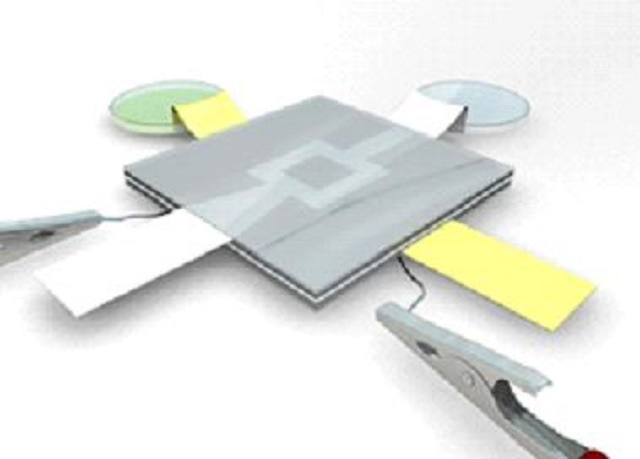Jul 5 2016
Iowa State University scientists have displayed a proof-of-concept 3D paper-based microbial fuel cell (MFC) that uses capillary action to direct the liquids via the MFC system and eradicate the requirement of external power. Their findings have been reported in the journal TECHNOLOGY.
 The device allows flow of the streams of Shewanella Oneidensis MR-1 (yellow) and the Potassium Ferricyanide (white) into the chambers. Proton exchange membrane is placed between the two chambers to separate the two liquids as well as allow the positively charged ions released in the biocatalytic breakdown of the anolyte to flow from the anode to the cathode. (Credit- Technology)
The device allows flow of the streams of Shewanella Oneidensis MR-1 (yellow) and the Potassium Ferricyanide (white) into the chambers. Proton exchange membrane is placed between the two chambers to separate the two liquids as well as allow the positively charged ions released in the biocatalytic breakdown of the anolyte to flow from the anode to the cathode. (Credit- Technology)
Due to the formation of biofilm on anode, current is produced in the paper-based MFC which runs for five days. The system produces 1.3 μW of power and 52.25 μA of current, yielding a power density of around 25 W/m3 for this study. These findings indicate that the paper-based MFCs can generate power in an eco-friendly manner without using any external power.
All power created in this device is useable because no electricity is needed to run the fluids through the device. This is crucial in the advancement of these devices and the expansion of their applications.
Nastaran Hashemi, PhD, Assistant Professor of Mechanical Engineering, Iowa State University
The finding that current measured is due to the biochemical reaction occurring was proved by the formation of biofilm on the carbon cloth in the test. This is significant as the biofilm plays a major role in the generation of current in a MFC. Increase in the size of the biofilm and its thickness eventually results in raise in current production. Separate bacterial cells metabolize electron-rich substances in a complicated process involving numerous enzyme-catalyzed reactions.
Using any one of the modes of electron transport, the electrons can freely move towards the anode. The electron transport is highly complex and there is proof that it is unique to every kind of bacteria. In the case of Shewanella Oneidensis MR-1, the majorly identified ways of shuttling electrons from the each bacterial cell towards the anode are via excreted soluble redox molecules, direct contact, and biological nanowires.
Excreted soluble redox molecules which serve as extracellular electron shuttles constitutes around 70% of electron transfer mechanisms from each bacterial cell towards the electrode. It has also been proven that direct contact among each S. Oneidensis MR-1 and the electrode has insignificant impact on the production of current, assisting in a mediated electron transfer mechanism. Biofilm assists the adsorption of the redox molecules to the electrode, which implies that they are essential in high power density MFCs.
There are not many reports on power generation from paper-based MFCs that run for a few days. Without sufficient time for the formation of biofilm, the current and power data that is reported would mainly be linked to extracellular electron transfer, which does not completely signify electrical producing abilities of MFCs. This instrument proves the longer period of use and ability to function independently, for the first time. It is a development that can raise the number of situations where MFCs could be functional.
Better options to regulate the voltage output are being explored by Iowa State University researchers at present. By controlling the environment tests, there would be proper systems output regulation which would result in improved results. In order to use optimally and reduce the cost, researchers are also keen on exploring an instrument that would not require the usage of Nafion and Potassium Ferricyanide. Niloofar Hashemi, Joshua Lackore, Farrokh Sharifi, Payton Goodrich, and Megan Winchell are the others co-authors of this paper.